As cities look to improve services without increasing taxes, energy efficient public buildings are gaining traction. At the League of Minnesota Cities on Tuesday, November 12th, thirty people representing fifteen Minnesota cities attended a workshop on “Better Buildings: Measuring, Retrofitting, and Financing.” The event was the first in a series being organized by Metro CERT as part of the Minnesota GreenStep Cities program.
Attendees included staff from both current GreenStep Cities and others looking to join the program, such as Elko New Market, which is expecting to pass its city council resolution this month (passing a resolution is considered “Step 1” and is the only requirement for joining the program).
The workshop featured the following speakers and city representatives who each laid out approaches that cities can take to manage and reduce their energy use in public buildings.
Establishing a Baseline
Katie Jones Schmitt, Energy Specialist at the Weidt Group, kicked off the workshop by showing how cities can establish a baseline of the energy usage and costs of their public buildings. The Weidt Group administers Minnesota’s B3 Benchmarking program, a free web-based tool in which cities can measure their energy and water usage in public buildings. “B3” stands for Buildings, Benchmarks, and Beyond, and is a larger statewide program to advance energy efficient public buildings in Minnesota, of which benchmarking is one piece.
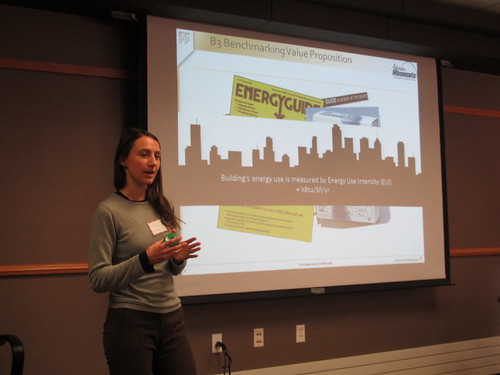 Schmitt explained that B3 Benchmarking is helpful because it can compare a building’s actual energy usage to the energy it would be expected to use if it were operating as efficiently as possible. “The goal [of using B3] is to bring all of the buildings up to that benchmark, [for] which the standard is today’s energy code,” she said.
Schmitt explained that B3 Benchmarking is helpful because it can compare a building’s actual energy usage to the energy it would be expected to use if it were operating as efficiently as possible. “The goal [of using B3] is to bring all of the buildings up to that benchmark, [for] which the standard is today’s energy code,” she said.
B3 Benchmarking also allows cities to establish targets for either a percentage reduction in energy use, or to meet a specified amount of energy consumed annually—both types of targets can be applied to individual buildings or the city as a whole. In addition to energy consumption, the tool also measures dollars spent on energy and CO2 emissions as a result of energy consumed. For measuring water usage, B3 Benchmarking can take into account irrigation, drinking water, pools, sanitary sewer, and stormwater.
Strategies for Success
Schmitt said that while automatic meter reading for B3 Benchmarking is being developed, it won’t be available for at least six months. In the meantime, cities need to either have a staff person manually enter data from utility bills, or pay an outside entity to enter it for them. The following are her strategies for success with getting started:
- Learn about B3: Attend a webinar (also see “Getting Started” below).
- Gather Building Meter Data: First, enter basic building information, including space types (e.g., garage, office, locker room), total floor area, and geographic location (this allows the tool to account for changes in weather when reporting energy usage) – this step is normally completed by a facilities manager. Second, enter at least one year of utility data to help with establishing a baseline. Most utilities can produce a yearly report of billing data that cities can upload into the system, expediting the process.
- Institutionalize Meter Reading Entry: Once a city has entered enough basic information to set a baseline for its buildings, it’s important to establish a process for entering data on a monthly basis. Schmitt recommends that this be done by an accounts-payable employee as part of the city’s bill-paying process – bills come in, utility data is entered, then bills are paid or distributed to the correct department for payment. This ensures that energy data is up to date, allowing facility managers to check up on the performance of their buildings at any time.
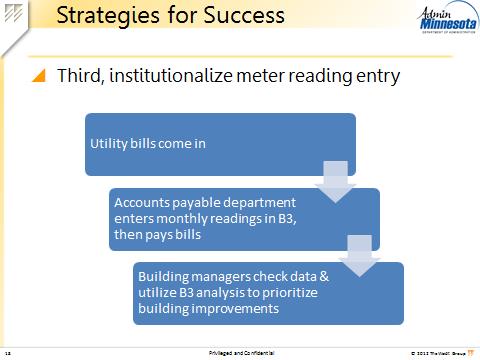
When asked why B3 Benchmarking is the best tool to use for energy measurement, Schmitt explained that while other tools, like the EPA’s Portfolio Manager, are popular among commercial building owners, B3 Benchmarking is tailored specifically to public buildings in Minnesota and offers more space usage types. Additionally, B3 Benchmarking is required for new city buildings funded by state bond dollars.
Getting Started
For cities looking to learn more about using B3 Benchmarking, Schmitt will be hosting two free webinars on December 4th from 10-11am and December 10th from 1-2pm. She recommends that both a facilities manager and an accounts-payable employee attend from each city. Click here to register.
To sign up for a B3 Benchmarking account, click here. City staff can also watch this instructional video from CERTs that shows how to use the B3 Benchmarking tool.
Benchmarking Testimony from City Employees
For cities that question whether they have the staff capacity to implement energy benchmarking, Debbie Engblom of the City of Shoreview has an answer. Engblom works in the city’s finance department and was tasked with setting up and entering information into the city’s B3 profile.
 “I didn’t know where to start,” said Engblom of the initial tasks required to set up a B3 Benchmarking account. With 30-40 invoices coming through her office each month, Engblom needed a way to keep track of which ones had information that should be entered into the B3 program. She decided to add a second line to the billing address for those invoices, stating “Add to MN Benchmarking.” This allowed her to easily identify invoices and work the data entry into her normal routine.
“I didn’t know where to start,” said Engblom of the initial tasks required to set up a B3 Benchmarking account. With 30-40 invoices coming through her office each month, Engblom needed a way to keep track of which ones had information that should be entered into the B3 program. She decided to add a second line to the billing address for those invoices, stating “Add to MN Benchmarking.” This allowed her to easily identify invoices and work the data entry into her normal routine.
According to Engblom, the data entry isn’t as time-consuming as it seems. “I could say it takes like 10 minutes, but it really doesn’t, it takes like two.”
Jay Strachota, Parks and Streets Superintendent at the City of Hopkins, tackled the initial effort of setting up a B3 benchmarking profile by working with interns. “They took and interviewed [the city building managers], got those questions answered, put the information in,” said Strachota.
After the interns set up the benchmarking account, city staff decided to meet every three months to review the performance of their public buildings. They identified three buildings that were performing in the bottom third of the B3 Benchmarking performance rating and decided to take action by investing in energy efficiency upgrades (click here to read an in-depth case study about the project). After its HVAC upgrade, the Hopkins city hall is saving $8,000 in energy costs annually.
Leveraging Financing with Energy Savings
With a better understanding for how cities can track energy usage, the crowd tuned in to Lindsay Wimmer, Outreach Coordinator for Minnesota’s Guaranteed Energy Savings Program (GESP), a statewide initiative that helps public entities to navigate the Energy Savings Performance Contracting process.
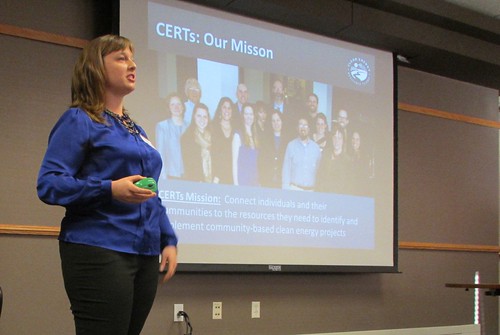 Wimmer explained that Performance Contracting is a method for financing the installation of energy efficiency and renewable energy measures that doesn’t require bonding or raising taxes. Instead, expected savings in maintenance, operations, and utility costs are leveraged upfront to finance energy reduction and building renewal retrofits that will produce those savings over time and pay off the initial investment.
Wimmer explained that Performance Contracting is a method for financing the installation of energy efficiency and renewable energy measures that doesn’t require bonding or raising taxes. Instead, expected savings in maintenance, operations, and utility costs are leveraged upfront to finance energy reduction and building renewal retrofits that will produce those savings over time and pay off the initial investment.
GESP vs. Performance Contracting
While Performance Contracting has been available as a financing tool under Minnesota State Law for several years, some local units of government have found it challenging to navigate the project process, which includes signing a contract with an Energy Service Company (ESCO) that will complete the retrofits and, if the expected savings are not realized, write a check to the local unit of government for the difference.
Rather than each city having to commit its own staff to manage the broader process and review contracts, GESP provides a statewide structure and oversight for performance contracting projects. Managed by the Minnesota Department of Commerce, GESP differs from regular Performance Contracting in the following ways:
- Assistance and oversight is provided by the State of Minnesota.
- Energy Service Companies are pre-qualified for participation through a Master Contract.
- Participating companies must provide open-book pricing (instead of unknown pricing methodology, a common criticism of Performance Contracting proposals).
- Mark-ups and fees for projects are limited to a pre-disclosed, maximum amount.
- Equipment and trade labor are procured through a competitive bidding process.
- Measurement and verification of energy savings are provided by an independent third party.
Click here to learn more about Minnesota’s Guaranteed Energy Savings Program
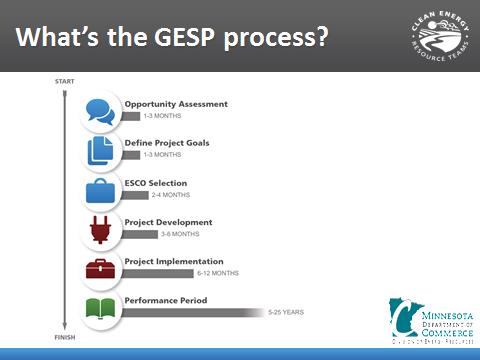
Performance Contracting in Brooklyn Park
Before GESP was available, the City of Brooklyn Park took on its own performance contacting project. According to Wayne Roehrich from the city’s Recreation and Parks department, the project covered a range of needed upgrades to city infrastructure, and amounted to a cost of 6.2 million dollars, 4 million of which went to a new geothermal cooling system at the city’s ice arena.
The ice arena project not only provided needed upgrades to one of the ice rinks, adding 25 years to its useful life, but it’s also saving the city $64,000 annually in energy related costs. Despite the high cost, performance contracting allowed the city to complete the entire project without any impact to taxpayers.
Financing Energy Retrofits Through Property Payments
Lastly, Eric Rehm from the Minnesota Department of Commerce presented on Property Assessed Clean Energy (PACE), a method for financing energy efficiency and renewable energy improvements by creating a special property assessment.
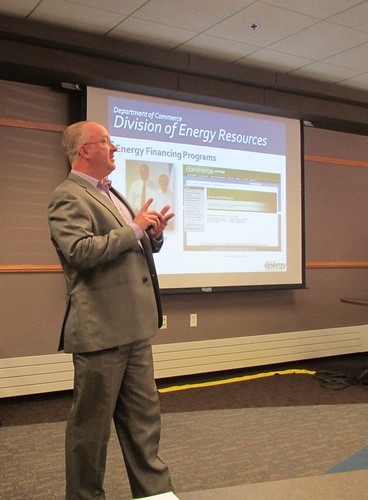 Rehm explained that PACE was first established in Minnesota by the 2010 legislature, which authorized any city, county or economic development commission to establish and implement a PACE financing program. He noted that PACE is similar to Performance Contracting in that “you’re identifying energy savings for a business and using those savings to pay for the investments.” However, one key difference is that “the cost of that investment gets assessed against the property, not the business owner.”
Rehm explained that PACE was first established in Minnesota by the 2010 legislature, which authorized any city, county or economic development commission to establish and implement a PACE financing program. He noted that PACE is similar to Performance Contracting in that “you’re identifying energy savings for a business and using those savings to pay for the investments.” However, one key difference is that “the cost of that investment gets assessed against the property, not the business owner.”
Rehm’s analogy for understanding PACE was that if there’s a sidewalk that needs repair, the city can make a special assessment against the property, allowing the property owner to make the repair and then pay for it through property payments over time. If the property is sold, the payments are passed on to the new owner (along with the new sidewalk).
The benefits of PACE are numerous and include reduced energy usage, increased business and property values, reduced greenhouse gas emissions, and the promotion of local jobs. Eligible projects under PACE legislation include lighting retrofits, motors, building envelope upgrades, energy management systems, and renewable energy installations.
For cities interested in PACE, there are currently three models for how the program can be administered in Minnesota:
- Locally administered – City or County administers entire program, including establishing guidelines, processing applications, selling revenue bonds, processing assessment repayments, and repaying the lender.
- Regionally administered – City collects assessment payments and transfers them to a regional program administrator. That administrator handles everything else.
- Statewide administered – Same structure as regionally administered, but on a statewide level.
So far, Edina is the only city that has established a locally administered PACE program. A regionally administered program is being developed in Southwest Minnesota. Most recently, the St. Paul Port Authority launched a statewide administered program, which the City of Eagan joined in early September.
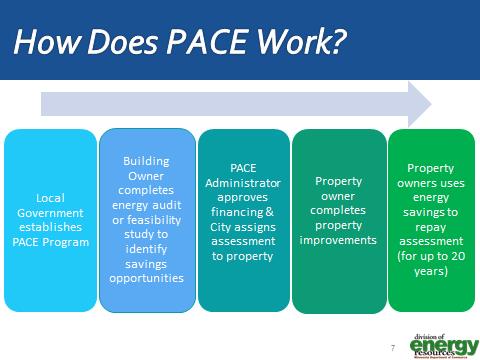
The next workshop in this series will cover “Efficiency on the Streets” and takes place on January 14th. Click here to register.
To see more photos from the event, click “play” below or click here.
About the Local Government Energy Action Series:
This year-long effort tells the stories of nearly 50 Minnesota municipalities, counties, and schools and the tangible results of their energy-saving efforts to inspire others to take their own actions.
Local Government Energy Action is brought to you by the Clean Energy Resource Teams (CERTs) in partnership with the Minnesota Department of Commerce, Division of Energy Resource


